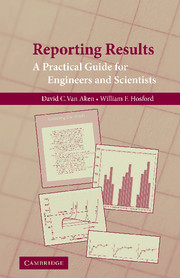Book contents
- Frontmatter
- Contents
- Preface
- REPORTING RESULTS
- 1 Elements of Technical Writing
- 2 Technical Papers
- 3 Technical Letters
- 4 Oral Presentations
- 5 Presentation of Technical Data
- 6 Statistical Analysis of Experimental Data
- 7 Resumé Writing
- Appendix I COMMON ERRORS IN WRITING
- Appendix II PUNCTUATION
- Appendix III COMMON WORD ERRORS
- Appendix IV INTERNATIONAL SYSTEM OF PREFIXES AND UNITS
- Appendix V THE GREEK ALPHABET AND TYPICAL USES
- Appendix VI STRAIGHT-LINE PLOTS FOR SOME MATHEMATICAL FUNCTIONS
- References
- Index
5 - Presentation of Technical Data
Published online by Cambridge University Press: 05 September 2012
- Frontmatter
- Contents
- Preface
- REPORTING RESULTS
- 1 Elements of Technical Writing
- 2 Technical Papers
- 3 Technical Letters
- 4 Oral Presentations
- 5 Presentation of Technical Data
- 6 Statistical Analysis of Experimental Data
- 7 Resumé Writing
- Appendix I COMMON ERRORS IN WRITING
- Appendix II PUNCTUATION
- Appendix III COMMON WORD ERRORS
- Appendix IV INTERNATIONAL SYSTEM OF PREFIXES AND UNITS
- Appendix V THE GREEK ALPHABET AND TYPICAL USES
- Appendix VI STRAIGHT-LINE PLOTS FOR SOME MATHEMATICAL FUNCTIONS
- References
- Index
Summary
This chapter covers some basic guidelines for presenting technical data. Tables, schematic drawings, photographs, and graphs quickly convey technical information and experimental results. A well-prepared table or figure immediately describes the significance of the work and provides a useful tool for the reader. Preparing tables and figures should be treated with the same care as writing a resumé. Technical reports are often the basis of patents, and the use of the standard international system of units (SI) is required for foreign and domestic patent applications. Appendix IV gives the international system of prefixes and units. Use of SI units is recommended, but the author should report in units and symbols most appropriate for the subject and the audience. Common uses of the Greek alphabet are provided in Appendix V. Results can also be reported using multiple units. This chapter also provides guidance for preparing graphs with multiple scales in different units.
Tables
Tables are helpful for presenting and archiving experimental data. Unlike graphs, tables preserve exact numbers for future analysis. Tables should be sequentially numbered (often with Roman numerals) in the order of presentation in the text. Alphanumeric numbering is used in long reports that are broken into sections. Each table should have a simple title at the top. Tables should be incorporated into the body of the text as soon as convenient after they are referred to (they should not be placed in the middle of a paragraph unless the paragraph breaks across pages), or they can be grouped at the end of the report.
- Type
- Chapter
- Information
- Reporting ResultsA Practical Guide for Engineers and Scientists, pp. 53 - 81Publisher: Cambridge University PressPrint publication year: 2008



